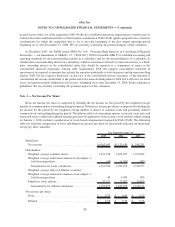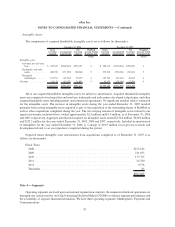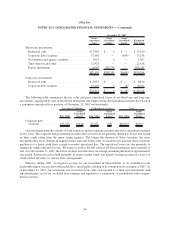eBay 2007 Annual Report Download - page 95
Download and view the complete annual report
Please find page 95 of the 2007 eBay annual report below. You can navigate through the pages in the report by either clicking on the pages listed below, or by using the keyword search tool below to find specific information within the annual report.amortized over the period of estimated benefit using the straight-line method and estimated useful lives ranging
from one to eight years. Goodwill is not subject to amortization, but is subject to at least an annual assessment for
impairment, applying a fair-value based test.
We evaluate goodwill, at a minimum, on an annual basis and whenever events and changes in circumstances
suggest that the carrying amount may not be recoverable. Impairment of goodwill is tested at the reporting unit level
by comparing the reporting unit’s carrying amount, including goodwill, to the fair value of the reporting unit. The
fair values of the reporting units are estimated using a combination of the income or discounted cash flows approach
and the market approach, which utilizes comparable companies’ data. If the carrying amount of the reporting unit
exceeds its fair value, goodwill is considered impaired and a second step is performed to measure the amount of
impairment loss, if any. We conducted our annual impairment test as of August 31, 2007. As a result of this test, we
concluded that the carrying amount of our Communications reporting unit exceeded its fair value and recorded an
impairment charge of approximately $1.4 billion during the year ended December 31, 2007. The impairment charge
includes the impact of the earn out settlement payment to certain former shareholders of Skype and was determined
by comparing the carrying value of goodwill in our Communications reporting unit with the implied fair value of the
goodwill. See “Note 3 — Business Combinations, Goodwill and Intangible Assets” for further details. There were
no events or circumstances from that date through December 31, 2007 that would impact this assessment.
Impairment of long-lived assets
We evaluate long-lived assets for impairment whenever events or changes in circumstances indicate that the
carrying amount of a long-lived asset may not be recoverable. An asset is considered impaired if its carrying amount
exceeds the future net cash flow the asset is expected to generate. If an asset is considered to be impaired, the
impairment to be recognized is measured by the amount by which the carrying amount of the asset exceeds its fair
market value. We assess the recoverability of our long-lived and intangible assets by determining whether the
unamortized balances can be recovered through undiscounted future net cash flows of the related assets. The
amount of impairment, if any, is measured based on projected discounted future net cash flows.
Revenue recognition
Our net revenues result from transaction, advertising and other fees generated in our Marketplaces, Payments
and Communications segments. Revenues are recognized when evidence of an arrangement exists, the fee is fixed
and determinable, no significant obligation remains and collection of the receivable is reasonably assured.
Our Marketplaces segment generates transaction revenues for listing, final value fee and feature fees and lead
referral fees. Listing and feature fee revenues are recognized ratably over the estimated period of the listing, while
revenues related to final value fees are recognized at the time that the transaction is successfully concluded. A
transaction is considered successfully concluded when at least one buyer has bid above the seller’s specified
minimum price or reserve price, whichever is higher, at the end of the transaction term. Lead referral fee revenue is
generated from lead referral fees based on the number of times a user clicks through to a merchant’s website from
our websites. Lead referral fees are recognized in the period in which the user clicks through to the merchant’s
website.
Our Payments segment earns transaction revenues from processing transactions for certain customers.
Revenues resulting from a payment processing transaction are recognized once the transaction is complete.
Our Communications segment revenues are recognized when the related service offering is provided. The
majority of Communications segment transaction revenues are prepaid. We record customer advances for prepaid
amounts in excess of revenues recognized as a current liability.
Our advertising revenues are derived principally from the sale of online advertisements. To date, the duration
of our advertising contracts has ranged from one week to five years, but is generally one week to one year.
Advertising revenues on contracts are recognized as “impressions” (i.e., the number of times that an advertisement
85
eBay Inc.
NOTES TO CONSOLIDATED FINANCIAL STATEMENTS — (Continued)
























